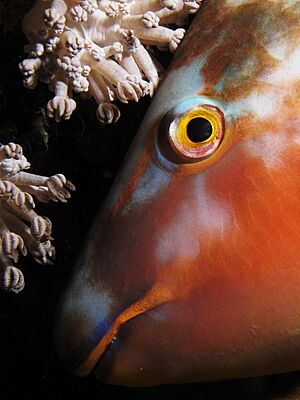Longnose parrotfish facts for kids
Quick facts for kids Longnose parrotfish |
|
|---|---|
 |
|
| A sleeping Longnose parrotfish from the Red Sea, Egypt | |
| Conservation status | |
| Scientific classification | |
| Synonyms | |
|
The Longnose parrotfish, also known as the Candelamoa parrotfish, is a colorful marine fish. Its scientific name is Hipposcarus harid. This fish is a type of parrotfish, named for its beak-like mouth. It lives on coral reefs in the Indian Ocean and the Red Sea.
Contents
Where Longnose Parrotfish Live
The Longnose parrotfish can be found in the western part of the Indian Ocean. This includes the Red Sea and goes south to the Mozambique Channel. You can also find them near places like Madagascar, the Seychelles, Sri Lanka, the Maldives, and the Chagos Islands.
Life on the Reef: Habitat and Biology
Longnose parrotfish love to live in coastal areas. They are often found around beautiful coral reefs and shallow reef flats. These fish usually live in groups called harems. A harem has one main male and several females. They also gather in large schools when they are looking for food.
How They Reproduce
Longnose parrotfish have a special way of reproducing. They are what scientists call "protogynous hermaphrodites." This means they can change their sex! They are born as females, but some can later change into males. When it's time to mate, a male and a female will form a pair. They are an "oviparous" species, which means the females lay eggs.
What They Eat
These parrotfish mostly eat algae that grows on the seafloor. They use their strong, beak-like mouths to scrape algae off rocks and corals.
Longnose Parrotfish and People
People sometimes catch Longnose parrotfish using nets and other traditional fishing tools. The fish are usually sold fresh in local markets.
The Hareed Festival
In the Farasan Islands in the southern Red Sea, something amazing happens every April. Many Longnose parrotfish gather in a shallow lagoon. No one knows exactly why they do this, but local people celebrate a festival called Hareed. During this festival, people catch the fish for prizes. Even though many fish are caught, the aggregation happens again every year. People have been eating and trading these parrotfish for a very long time, even back in the Byzantine Empire.



